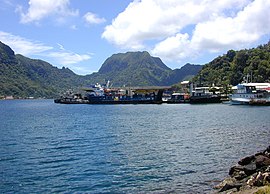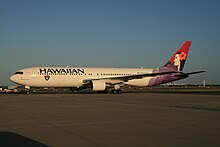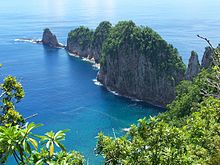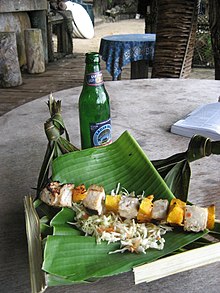American Samoa is a U.S. territory in the South Pacific Ocean that lies about 100 km (60 mi) east of its neighboring country of Samoa, which is part of the same archipelago. American Samoa consists of five main islands and two coral atolls; the largest and most populous island is Tutuila, with the Manuʻa Islands, Rose Atoll and Swains Island also included in the territory.
American Samoa is not well developed for tourism, and there are no five-star hotels. But it is a great place for lounging on a beach, hiking the national park, snorkeling the lagoons, visiting historical World War II sites, or diving in the marine sanctuary.
Regions
edit
| Tutuila The largest and by far the most populous island. |
| Ofu Widely regarded as one of the most stunning beaches in the South Pacific, with its high peaks dropping dramatically to sparkling white sand beaches, where the only other footsteps apart from your own are those of crabs. |
| Olosega Connected by a narrow bridge to neighboring Ofu. |
| Ta'u |
| Rose Atoll The Rose Atoll Marine National Monument/Rose Atoll NWR is the southernmost point in United States territory and is not open to tourists. The only legal way to get there is as a scientist. |
| Swains Island A privately owned island far to the north of the other portions of American Samoa and culturally part of Tokelau. No tourist facilities. |
Cities
editOther destinations
edit- 1 Fagatele Bay National Marine Sanctuary - a tropical reef, filled with all sorts of brightly-colored tropical fish including parrot fish, damselfish and butterfly fish, as well as other sea creatures like lobster, crabs, sharks and octopus.
- 2 National Park of American Samoa - The Samoan village leaders and the U.S. Congress have set aside the finest samples of the islands' land and seascapes as a national park.
Understand
edit
American Samoa is an unincorporated territory of the United States of America. The citizens of American Samoa are US "nationals" and not US "citizens," but they are allowed to travel freely between American Samoa and the U.S. mainland. They are not required to obtain green cards or visas to stay or work in the United States, and they are allowed to serve in the U.S. armed forces (and often do). There are some ways that American Samoa's special status as an unincorporated territory has interesting legal consequences. The U.S. Constitution is not necessarily the supreme law of the land in American Samoa, and Samoan cultural norms, in particular those related to the ownership of property and public displays of religion, actually trump certain well-settled U.S. constitutional rights in American Samoa.
The main city is Pago Pago and the smaller Fagatogo is the constitutionally designated seat of government. The governor's office is in the village of Utulei, on the opposite side of Fagatogo from Pago Pago.
The islands are frequently referred to as Samoa, which is the name of a separate island, and independent country, that used to be known as Western Samoa, that lies about 100 km west of American Samoa. Also the whole island group, including Samoa, is often identified as the Samoan islands.
Settled as early as 1000 BCE by Polynesian navigators, Samoa was reached by European explorers in the 18th century. International rivalries in the latter half of the 19th century were settled by an 1899 treaty in which Germany (later Britain) and the U.S. divided the Samoan archipelago. The U.S. formally occupied its portion, a smaller group of eastern islands with the excellent harbor of Pago Pago in the following year.
American Samoa is warm, humid and rainy year-round, but there is a long, wet summer season (October - May) and a slightly cooler and drier season (June - September). Total annual rainfall is 125 in (3,200 mm) at the Tafuna airport and more than 200 inches in mountainous areas. Such rainfall gave the English writer Somerset Maugham the name for his short story "Rain", based in Pago Pago, which was subsequently turned into a play and movie.
90% of the land in the group of islands is communally owned. Economic activity is strongly linked to the U.S. and the greater part of its foreign trade is with the U.S. The private sector is dominated by tuna fishing and the tuna processing plants, canned tuna being the primary export. Monetary transfers from the US Government also add substantially to American Samoa's economic well-being. Since the emergence of U.S. influence and control the government of the United States of America has put up resistance to the emergence of local independence movements. In the early 20th century the American Samoa Mau movement was actively suppressed by the U.S. Navy.
The Governor of American Samoa is the head of government and exercises executive power. American Samoa is an unincorporated and unorganized territory of the United States, administered by the Office of Insular Affairs, U.S. Department of the Interior. Its constitution was ratified in 1966 and came into effect in 1967.
In both American Samoa and (independent) Samoa there is traditional village political system common to all of the Samoa Islands, the "fa'amatai" and the "fa'asamoa" interacts across the current international boundaries. The Fa'asamoa represents language and customs, and the Fa'amatai the protocols of the "fono" (council) and the chief system. The Fa'amatai and the Fono take place at all levels of the Samoan body politic, from the family, to the village and include regional and national matters.
- American Samoa Visitors Bureau, Level 1, Suite #200, Haleck Center (Corner Ottoville Rd & Ili'ili Rd, Ottoville, Pago Pago), ☏ +1 684 699-9805, fax: +1 684 699-9806, info@americansamoa.travel.
Get in
edit
Visas
editAmerican Samoa lies outside federal U.S. immigration and customs jurisdiction. All visitors (except U.S. citizens and green card holders) to American Samoa require a passport valid for six months or more, a return ticket or onward ticket and enough funds to support their stay. U.S. citizens and green card holders traveling from the U.S. may enter without ID, though it is still recommended[dead link].
However, since American Samoa has an immigration system independent from the U.S., U.S. Green Card Holders traveling to American Samoa from another country (namely Apia Fagali’i Airport as it is the only foreign gateway) still have to present their passports, and if they are not citizens of any American Samoa Entry Permit Waiver Countries, they still need to acquire an American Samoa entry permit before traveling. The only exception may be passengers on transit to another U.S. destination (Apia-Pago Pago-Honolulu), who are granted to stay in Pago Pago for 24 hours. Regular U.S. visas are not valid for visiting American Samoa.
Passports not requiring visas
editCitizens of countries under the federal Visa Waiver Program, plus Canada, the Federated States of Micronesia, Palau and the Marshall Islands may visit for up to 30 days with an "OK to board". Citizens of Samoa are permitted to visit for up to 7 days with an "OK to board".
To obtain an "OK to board", travelers must apply online, and upload a copy of their passport (valid for at least 6 months after planned departure from American Samoa) and a copy of their round-trip or onward ticket at least 3 business days before travel. It costs $10 for Samoan citizens, and $40 for all other nationalities, which must be paid when you submit your application.
To obtain a business or residence visa or to extend your stay to 60 days, you must visit the Attorney General's office after arrival.
Passports requiring visas
editAll other international passport holders intending to visit American Samoa for business or holiday are required to apply for a visa (called an entry permit). This will require a local sponsor in American Samoa to apply and pay the required fees on your behalf. You must obtain a copy of the entry permit in order to check-in for your flight to American Samoa, and your sponsor must present the original copy in person to immigration when you arrive. Alternatively, your sponsor can mail the original copy to you, so you can present it yourself to check-in staff for your flight and at immigration on arrival. If you are joining a package tour, the tour company might be able to arrange this for an extra fee; check with them to be sure.
By plane
edit
There is one international airport, Pago Pago International Airport (PPG IATA), with a runway length of 2,750 m (9,000 ft). This is also referred to as Tafuna Airport (or Tafuna International Airport) and is at Tafuna 5 km (3 ml) southwest of the central business district of Pago Pago on the island of Tutuila.
- Hawaiian Airlines operates 2 return flights per week from Honolulu with Boeing 767 aircraft.
- Samoa Airways operates services to Pago Pago from Maota airport (MXS IATA) on Savaii Island in (independent) Samoa.
- Talofa Airways operates flights to Pago Pago from Faleolo International Airport (APW IATA) in (independent) Samoa.
Faleolo International Airport (APW IATA) also serves as an international gateway to the region. That airport is 40 km (25 mi) west of Apia, the capital of (independent) Samoa. Daily inter-island flights between the Samoas are operated by Samoa Airways and Talofa. Samoa is in the western part of the Samoan islands archipelago.
The Faleolo airport in nearby Samoa has wider international connections including Air New Zealand to Auckland in New Zealand, Fiji Airways to Honolulu USA and Nadi in Fiji, Samoa Airways to Maota in Samoa and Pago Pago in American Samoa, Tongatapu in Tonga, Polynesian Blue (operated by Pacific Blue) to Auckland in New Zealand, Brisbane and Sydney in Australia.
The 2 airlines operating international services between Pago Pago and Apia, Samoa provide scheduled daily flights.
- Samoa Airways. Operate a 19-seater Twin Otter aircraft.
- Talofa Airways Operates two 9-seater Twin Commander 690B aircraft.
By boat
editThe island of Tutuila has the international seaport of Pago Pago. This port is served by a number of passenger carrying cruise ships and cargo ships.
Get around
edit
By plane
editSamoa Airways is the only airline providing daily domestic air services between Pago Pago and the Manu'a Island of Tau.
- Flight time between Pago Pago and the Manu'a Islands is approximately 30-40 min. Samoa Airways will generally add additional flights as needed.
Fitiuta Airport (FTI IATA), (FAA LID: FAQ), 975 x 23 m (3,200 x 75 ft) is a public use airport in the village of Fiti‘uta on the northeast portion of Ta‘ū island.
- Samoa Airways operates flights between Fitiuta Airport on Ta‘ū island and Apia (Faleolo International Airport (APW IATA) in (independent) Samoa. Upon arrival at Ta'u airport, locals with boats are available to take visitors to Ofu and Olosega islands.
Ofu Airport (OFU IATA) has a public airport one 2 km (1.2 mi) southeast of the village of Ofu on the island of Ofu which is not served by a commercial airline.
- Samoa Airways operates flights to Ta‘ū island
Tau Airport (TAV IATA) 661 x 30 m (2,170 x 100 ft) is a privately owned, private-use airport 2 km (1 mi) southeast of the village of Ta‘ū in the northwest corner of Ta‘ū island. It is not normally utilized for scheduled services.
Rose Island (Rose Atoll) and Swains Island do not have an airport.
By car
editSeveral car rental facilities are available at or near the Tutuila airport. On Tutuila taxis are available at the airport, and near the market in Fagatogo.
By bus
editThe island of Tutuila has good public transportation (frequent, but unscheduled) via "aiga" or "family" buses. For 50 cents to a dollar you can be taken around Pago Pago Harbor, and to the more remote parts of the island. Buses originate and terminate at the market in Fagatogo, the village next to Pago Pago. The roads are generally too narrow and the traffic too busy for bicycles.
Hail an aiga bus with a wave of your hand. Many Samoans carry a quarter or two in their ears for bus fare as the wraparound skirts (lavalava) don't have pockets. When you want off, tap the window a few times and the bus will stop and pay the driver by tossing your fare (a quarter up to a dollar depending on the route and distance traveled) onto the dashboard on your way out.
By boat
editA weekly ferry service from Pago Pago to the Manu’a Islands is provided by government operated excursion boat. This service travels around Tutuila, calling at the north coast villages of Afono, Vatia and Fagasa. Regular small ferries also offer service to and from the island of Aunuʻu.
Talk
editThe native language is Samoan, a Polynesian language related to Hawaiian and other Pacific island languages. The Samoan language is still in use in daily exchange. English is widely spoken, and most people can at least understand it. Most people are bilingual to some degree.
Some common words/phrases:
- Hello - Talofa (tah-low-fah)
- Please - Fa'amolemole (fah-ah-moh-lay-moh-lay)
- Thank you - Fa'afetai (fah-ah-feh-tie)
See
edit
- Fatu ma Futi or Flower Pot Rock, about 275 m (900 ft) out in the ocean stands a tall mini-island. It is home to many exotic birds and fruit bats.
- Fagatele Bay National Marine Sanctuary (requires a steep, moderately difficult hike)
- National Park of American Samoa, including the view of Pola Island, AKA Cock's Comb
- Turtle and Shark Site - Beautiful small cove in Vaitogi central to an ancient Samoan legend
- Tia Seu Lupe - The most accessible of American Samoa's ancient star mounds, used for the chiefly sport of pigeon catching, in Ottoville near Holy Family Catholic
- Blunt's Point Battery - Incredibly well-preserved WWII defensive cannons atop a mountain with a spectacular view. Accessible via a trail with a small, unassuming entrance to the right of the laundromat in Utulei.
Do
edit- To'aga Beach on the south side of Ofu. Bring your snorkel to explore the pristine coral reef that fringes its shore.
- There is abundant hiking on the island, especially in the National Park of American Samoa
- Tisa's Barefoot Bar & Grill on the eastern part of the island. Beach access but no shower. Features weekly umu feasts of traditional Samoan foods and an annual tattoo festival.
- Two Dollar Beach is a beautiful beach in Avalo with great snorkeling and many fish darting anong the rocks in its tranquil waters. Very affordable, even if it isn't just $2 anymore.
Events
edit- Flag Day Fautasi Races- Held on April 17th, the day the US flag was first raised over the territory. A team from each of the bigger villages races a fautasi, or 50-person longboat, in Pago Harbor.
- Tisa's Tattoo Festival- Festival of traditional body inking held every October at Tisa's Barefoot Bar in Alega.
Buy
editMoney
edit|
Exchange rates for U.S. dollars
As of January 2024:
Exchange rates fluctuate. Current rates for these and other currencies are available from XE.com |
American Samoa uses the U.S. dollar ("$, ISO code currency: USD). It is divided into 100 cents.
Shopping
editAmerican Samoa has a lot of locally run shops and kiosks with products ranging from handmade clothing to traditional wooden weapons. A covered market operates in Pago Pago when cruise ships are in town. There is also a mini-mall, Laufou Shopping Center, in Nu'uuuli.
Eat
edit
Tutuila has a wide variety of places to eat—from familiar fast food stops to fine restaurants. The outer islands have far less variety. Restaurants offer a variety of cuisines, including American, Chinese, Japanese, Italian and Polynesian. Tisa's Barefoot Bar in Alega holds weekly traditional Samoan Umu feasts.
Signature/national dishes include Palusami, Lu'au and Supoesi.
Drink
editKava is often considered to be the national drink. The beverage is made from the roots of the pepper plant (Piper methysticum). Kava is known for its mellow and relaxing effects. Many people drink kava because it is a natural alternative to alcohol and anti-anxiety/anti-depressant medication.
Flying Fox Brewing Company in Pava'ia'i is the island's first and only brewery.
Sleep
editThere is hotel-style lodging on the main islands, but not Olosega, Swains, or Rose (uninhabited).
Work
editThe tuna industry is very prominent, but about 30% of the population is unemployed.
Stay healthy
editAmerican Samoa has few health risks of concern for normally healthy persons visiting the islands. There are, however, a significant number of cases of dengue fever each year, and (since 2014) chikungunya, both spread by mosquitoes, so don't forget your insect repellent (containing DEET).
Another common danger, in or near residential areas, are packs of stray dogs. Most dogs, while they may nominally belong to someone, are left to fend and forage for themselves. They are territorial, and will often bite. The most common response by locals is to pretend to bend down and pick up a rock. This will often scare the dogs away because they are used to being abused and hit with thrown rocks.
Bring necessary medications with you, for supplies may not be available. Medical care is limited and there is none available on the Manu’a Islands. The LBJ Tropical Medical Center is on Tutuila island in the village of Faga'alu. It was once a highly regarded regional health center; however, it has fallen on hard times. It has staffing problems and only provides marginal (though inexpensive) service. A serious illness or injury will generally be evacuated to a hospital in Hawaii, Fiji, or New Zealand. When traveling in the region, carry some basic medications such as aspirin or paracetamol (acetaminophen/Tylenol), cold capsules, band-aids, sun screen, vitamins, anti-diarrhea pills, and a good insect repellant.
In many areas of Tutuila, the tap water is not safe for drinking or washing dishes due to E. coli contamination. Check with the American Samoa Environmental Protection Agency for details or drink bottled water.
Stay safe
editAmerican Samoa has low crime rates, though it's best to stay where the crowds are while on the beach. While swimming, don't go too far out, as rip tides are common. Keep a close eye on your valuables, as theft is also common.
Respect
edit
Except for perhaps a few thousand individuals nearly all inhabitants of American Samoa are indigenous Samoans of Polynesian ancestry. More than any other U.S. or Polynesian peoples, Samoans are oriented toward traditional customs and lifestyles. They closely follow the social customs and hierarchies developed prior to the arrival of the first Europeans in the region. This Samoan way, or fa'asamoa is still deeply ingrained in American Samoa culture.
The most apparent character is the Samoan matai system of organization and philosophy. In general, each village is made up of a group of aiga, or extended families, which include as many relatives as can be claimed. Each aiga is headed by a chief, or matai, who represents the family on all matters including the village council, or fono. Matais hold title to all assets of the aigas, or families; they represent and are responsible for law enforcement and punishment of infractions occurring in their villages.
The fono consists of the matais of all the aiga associated with the village. The highest chief of the matais of all the village aigas is the highest chief, or the ali’i, and heads the fono. Also, each village has a pulenu’u (somewhat like a police chief or mayor), and one or more talking chiefs, tulafale.
Over the centuries, distinct cultural traits emerged that we now call fa'asamoa (fah-ah-SAH-mo-ah). Whether you are a guest or simply passing through a village, please observe these customs as a sign of respect.
Follow the Samoan Way:
- Always ask villagers for permission before taking photographs, using the beach, or engaging in other activities, however unobtrusive your actions may seem. Permission will almost certainly be granted.
- In a traditional home, called a fale (fah-LAY), sit down on the floor before talking, eating, or drinking. Cross your legs or pull a mat over them; it is impolite to stretch out your legs uncovered.
- Sunday is the day for church, for rest, and especially for quiet around the villages. Activities that are acceptable on other days, such as swimming, may not be permitted on Sunday.
- Each evening around dusk, villagers observe a time for prayers called Sa. If you are entering a village during Sa, stop and wait quietly until Sa ends. You may even be invited to join in a family prayer. It is not necessary to stop for Sa on the main roads.
- It is considered an honor to be asked to share kava (a local drink made from the root of the pepper plant). To show respect, spill a few drops on the ground or mat in front of you, then raise your cup and say "manuia" (mahn-ooh-WE-ah) before drinking.
- Do not eat or drink while walking through a village.
- It is very disrespectful to walk in a village when a sacred ritual is in progress.
Connect
editAmerican Samoa uses the U.S. Postal Service with zip code 96799 and a state code of "AS". Postage between Hawaii, American Samoa, the mainland, and overseas military & diplomatic installations (APO, FPO, DPO addresses) is charged at the same domestic rates as it would be within a single island or between the islands of American Samoa.
American Samoa's area code is 684. When dialing any off-island telephone number, dial 1 + area code + phone number. Check with your phone/long distance company to regarding the rates.
American Samoa is not covered by US mainland mobile phone operators. There are two local mobile providers- BlueSky and ASTCA. iPhone users can freely choose either of the two, but not all Android devices are supported by the ASTCA network, so some Android users may be limited to BlueSky. Additionally, if continuing to Samoa later, BlueSky SIMs will roam in Samoa with the same pricing as local usage on certain data bundles (but not for voice or text, which are charged extra). If you have a data-only device such as an iPad or hotspot device, BlueSky also offers data-only prepaid plans (pricing details are here).
In addition to mobile data, ASTCA and BlueSky both offer a few WiFi hotspots around Tutuila. ASTCA hotspots cost $2 for 24 hours of unlimited usage at up to 3Mbps, $10 for 7 days of unlimited usage at up to 10Mbps, and $40 for 30 days of usage at up to 20Mbps. BlueSky hotspots charge by usage instead of speed and time, and their pricing table can be found here.


